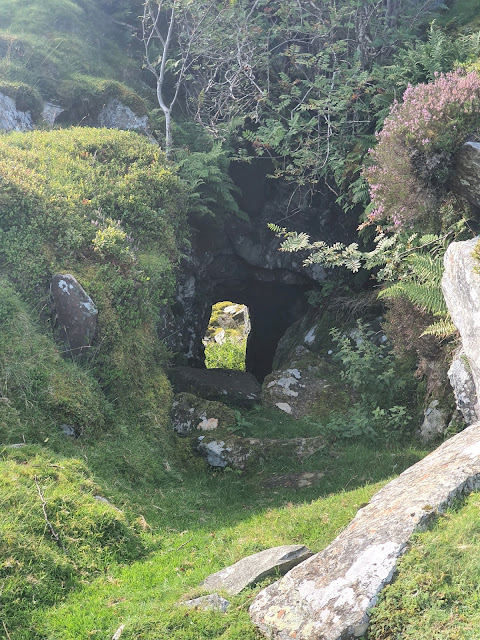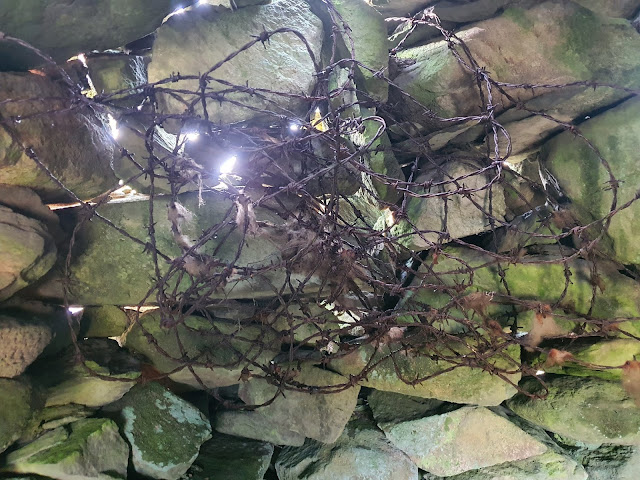How could I have lived here almost all my life, and not have known that there was a quarry at the back of Tal y Fan? There's a lot I didn't know about Tal y Fan. I didn't know until a few years ago that there was a small ring fort, Caer Bach, sitting there at the end of the mountain. I didn't know that on its slopes lay Pen y Ffridd, the home of 'Huw Tom' (Huw Thomas Edwards) the 'unofficial Prime Minister of Wales.' I didn't know about Maen Penddu, the great standing stone that stands behind the mountain. I didn't know about the eastern end or the northern side, basically because they were out of my territory. I didn't even know that the end of the ridge was a distinct mountain, Foel Lwyd (confusingly, there's another Foel Lwyd opposite this one, at the end of Drum). I hadn't seen the top of the mountain since I was a child - I have a memory of walking up there in the snow with my uncle and his two dogs, but little more - and didn't know about the unexpected broadness, sudden valleys, and little pools you come across as you walk its length. Now I walk, my territory has become bigger.
When a friend went walking recently, and posted photos of a lovely little quarry building, I wanted to know where it was. Tal y Fan, she said. I was astounded. I had to go and look myself.
You could approach this quarry a number of ways. The easiest would probably be by parking near Llangelynnin Old Church and walking across the fields from there. A longer walk is up the track from Cae Coch on 'my' side of the mountain, above the more heavily used Roman road, past Huw Tom's house, towards Caer Bach and around the end of the mountain. Either way you'll be walking off road along stony tracks.
The quarry is located at Ordnance Survey grid reference SH 7381 7323. The Coflein entry has a little more detail on it.
The quarry is nestled against the back (the north side) of Tal y Fan, near the eastern end.
The old quarry track is still good, and used frequently by walkers and mountain bikers.
I saw a few Carneddau ponies grazing around the area.
The track leads up between two large tips.
This is the little building that first piqued my interest. A lovely little shelter built entirely of slate, unusual in that it still has its roof, probably because it's low, and also because no wood beams were involved.
Just past this little building, the entrance to the quarry can be seen.
Looking in through something of a window, into the little slate shelter.
The shelter has a curious, igloo-like entrance; a short tunnel that you have to crawl to go through.
Inside are rudimentary low slate benches for sitting on.
A small fireplace is at one end of the shelter.
The roof is built of hefty stone slabs.
A wide angle shot showing the low benches, slab roof, and fireplace at the end.
A butterfly appearing to be hibernating inside. Since it was summer, maybe it was just resting?

The massive stone lintel over the inside end of the passageway.
The narrow passageway into the shelter.
The view from the shelter doorway, rather idyllic in this weather.
Outside, on the slate tip, the remains of a small building.
A very small shelter was built on the edge of the tip.
The small shelter on the edge of the tip.
The small shelter, which has presumably lost most of its roof.
A trolleyway on top of the tip, leading to the edge. According to Coflein, there was at least one sleeper remaining here, although I couldn't see any sign of it.
The entrance to the quarry is a rather magical cleft made by a passageway cut through the rock.
The floor of the passageway is littered with slabs of slate and puddled with water.
It's a relatively small space, scattered with slabs of slate.
Greenery is taking back this cleft in the land.
The cliffs are rather beautiful, even if they were created with violence.
Some of the loose, scattered slates on the ground.
Up at the side of this enclosed bowl, is the entrance to a small tunnel.
Standing at the tunnel entrance, looking down into the quarry.
The tunnel is only a short one, and leads from the inside of the quarry to the hill outside.
There's a large crack in the stone above the tunnel entrance.
A rock part-blocks the exit onto the hillside.
The exit is a magical opening fringed with ferns and leaves, leading onto a flat level with a small building.
On the level outside the tunnel are the remains of another building.
The view from this level, out over the slate tip and the valley beyond.
Looking down into the quarry bowl, through the trees.
Looking back through the tunnel from the other side.
The inside of the building on the first level.
There's a fence around above the edge of the quarry, and a lot of these signs, which are damaged and faded but still show the danger.
Looking out from one of the tips, over towards the coast.
Sheep are no respecters of fences, or warning signs. There's a clear path under this damaged fence.
Lookig down over the quarry bowl from above.
The view out between slate tips.
On a rather hazy day, the view past the slate tip is still beautiful.
There are a number of small buildings near the quarry, clustered around OS grid reference SH 7388 7349, but it's uncertain whether they're associated with it or not.
This is rather an intriguing structure, not far from the quarry.
Coflein mentions this as a 'peat house,' although their entry is a little confusing because not all the photos seem to be of the same thing and the grid reference isn't the same as this building, so I assume they've taken photos of a number of peat houses in the area, and this is just one of them. It's a very narrow building, and long. More investigation is required, I think.
Looking out from the strange narrow building.
This building is roofed with slate slabs, and the top is covered with earth and moss.
Rusty barbed wire, shoved into the top of the wall at the end of the building.
What looks like a small trough or seat at the end of the building. I'd wondered if it were an outhouse, but there's no hole for cleaning it out.
A random stone with the appearance of a standing stone, near the path leading from the quarry and past these buildings. It's hard to know with stones like this if they're natural or placed there by people. The odd narrow building is just beyond in this photograph.
The ponies were still hanging around near the quarry. The land on the south side of the mountain is fenced, and I've never seen ponies there, but there seem to be a lot on the unenclosed mountain and moorland on the north side.
Another of the little stone buildings, quite ruined. They're built of local, undressed stone, not slate from the quarry.
These buildings are very tumbled and it's hard to know what their original purpose may have been.
One of the little buildings in its sheltered setting near the quarry.
There are three of these buildings near to each other (including the peat house), with a few a little further away around the quarry and one, in the first photo in this blog entry, up on the other side of the track. The first may be a fold rather than a building.
On the other side of the ruins from the quarry stands Maen Penddu, a large standing stone on the junction of a few tracks, which has been sadly graffitied by passers-by, scratched into with large scrawls and a Christian cross. This photo is from another walk, which I hope to cover in a later post.

























































No comments:
Post a Comment